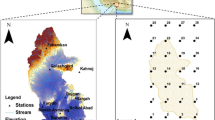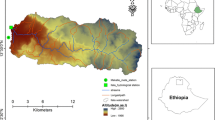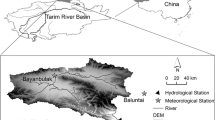Abstract
One of the difficulties in hydrological models is the collection of meteorological data especially in large catchments. This issue is more obvious in the case of semidistributed hydrological models, which need long periods of meteorological data such as precipitation and temperature to perform watershed practices such as hydrological cycle and sustainable development. Moreover, this issue is significant for arid regions that generally have sparse data and lack of weather stations, especially in develo** countries. In this study, Climate Forecast System Reanalysis model had been applied for Soil and Water Assessment Tool hydrologic simulator generate daily flow prediction for a catchment including dry climate. Required data for development of hydrologic simulator have been prepared in Geographic Information System database. Then, model has been calibrated via semiautomatic method namely Sequential Uncertainty Fitting 2. Results of study show that application of renewed meteorological data is promising for flow prediction. Also, accuracy of model according to Nash and Sutcliffe obtained efficiency of 0.54 for calibration and 0.45 for validation, respectively. In summary, it can be concluded that results’ quality classified as good for calibration and fair for validation according to Nash and Sutcliffe efficiency.
Access this chapter
Tax calculation will be finalised at checkout
Purchases are for personal use only
Similar content being viewed by others
References
D.R. Fuka, M.T. Walter, C. MacAlister, A.T. Degaetano, T.S. Steenhuis, Z.M. Easton, Using the Climate Forecast System Reanalysis as weather input data for watershed models. Hydrol. Process. 28(22), 5613–5623 (2013). doi:10.1002/hyp.10073
F. Konukcue, A. Istanbulluoglu, I. Kocaman, Determination of the water yields for small basins in semi-arid area: Application of the modified Turk method to the Turkey’s condition. J. Cent. Eur. Agr. 6, 263–268 (2005)
A.A.H. Al-Qurashi, N. Mclntyre, H. Wheater, C. Unkrich, Application of the Kineros2 rainfall-runoff model to an arid catchment in Oman. J. Hydrol. 355, 91–105 (2008)
Y.T. Dile, R. Srinivasan, Evaluation of CFSR climate data for hydrologic prediction in data-scarce watersheds: An application in the Blue Nile River Basin, J. Am. Water Resour. Assoc. 50(5), 1226–1241 (2014)
R.A. Smith, C.D. Kummerow, A comparison of in situ, reanalysis, and satellite water budgets over the Upper Colorado River Basin. J. Hydrometeorol. 14, 888–905 (2013)
S. Saha, S. Nadiga, C. Thiaw, J. Wangw, W. Wang, Q. Zhang, H.M. Van Den Dool, H.L. Pan, S. Moorthi, D. Behringer, D. Stokes, M. Peña, S. Lord, G. White, W. Ebisuzaki, P. Peng, P. **e, The NCEP climate forecast system. Am. Meteorol. Soc. 19, 3483–3517 (2006)
F.C. Sperna Weiland, C. Tisseuil, H.H. Durr, M. Vrac, L.P.H. van beek, Selecting the optimal method to calculate daily global reference potential evaporation from CFSR reanalysis data for application in a hydrological model study. Hydrol. Earth Syst. Sci. 16, 983–1000 (2012)
A.R.S. Shargh, Comprehensive studies of water resource management for Roodan watershed, Synthesis report of Roodan. Consulting Water Resource Engineering Corporation, register code 14800 Mashhad, Iran, 2009
P.W. Gassman, A.M. Sadeghi, R. Srinivasan, Applications of the SWAT model special section: Overview and insights. J. Environ. Qual. 43(1), 1–8 (2014)
J.G. Arnold, D.N. Moriasi, P.W. Gassman, K.C. Abbaspour, M.J. White, R. Srinivasan, C. Santhi, R.D. Harmel, A. van Griensven, M.W. Van Liew, N. Kannan, M. Jha, SWAT: Model use, calibration, and validation. Am. Soc. Agr. Biol. Eng. 55(4), 1491–1508 (2012)
K.C, Abbaspour, M. Vejdani, S. Haghighat, SWATCUP calibration and uncertainty programs for SWAT, in Proceedings of the International Congress on Modelling and Simulation (MODSIM’07), Modelling and Simulation Society of Australia and New Zealand, Australia, 2007
P. Krause, D.P. Boyle, F. Base, Comparison of different efficiency criteria for hydrological model assessment. Adv. Geosci. 5, 89–97 (2005)
P.B. Parajuli, N.O. Nelson, L.D. Frees, K.R. Mankin, Comparison of AnnAGNPS and SWAT model simulation results in USDA-CEAP agricultural watersheds in south-central Kansas. Hydrol. Process. 23, 748–763 (2009)
S.L. Neitsch, J.G. Arnold, J.R. Kiniry, J.R Williams, Soil & Water Assessment Tool Theoretical Documentation Version 2009. Grassland, Soil and Water Research Laboratory—Agricultural Research Service Blackland Research Center—Texas AgriLife Research, Texas Water Resources Institute Technical Report No. 406 Texas A&M University System College Station, TX, 2011
Acknowledgment
We deeply appreciate the Research Management Center (RMC) of Universiti Teknologi Malaysia for funding this research under postdoctoral fellowship scheme. We are thankful to all members of consultant engineers of Ab Rah Saz Shargh Corporation in Iran and the Regional Water Organization, Agricultural Organization, and Natural Resources Organization of Hormozgan province, Iran. We also wish to acknowledge Dr. Philip W. Gassman at the Center for Agricultural and Rural development, Iowa State University for introduction of SWAT model and related new contributions.
Author information
Authors and Affiliations
Corresponding author
Editor information
Editors and Affiliations
Rights and permissions
Copyright information
© 2015 Springer Science+Business Media Singapore
About this paper
Cite this paper
Jajarmizadeh, M., Harun, S., Kuok, K.K., Sabari, N.S. (2015). Contribution of Climate Forecast System Meteorological Data for Flow Prediction. In: Abu Bakar, S., Tahir, W., Wahid, M., Mohd Nasir, S., Hassan, R. (eds) ISFRAM 2014. Springer, Singapore. https://doi.org/10.1007/978-981-287-365-1_8
Download citation
DOI: https://doi.org/10.1007/978-981-287-365-1_8
Publisher Name: Springer, Singapore
Print ISBN: 978-981-287-364-4
Online ISBN: 978-981-287-365-1
eBook Packages: Earth and Environmental ScienceEarth and Environmental Science (R0)




